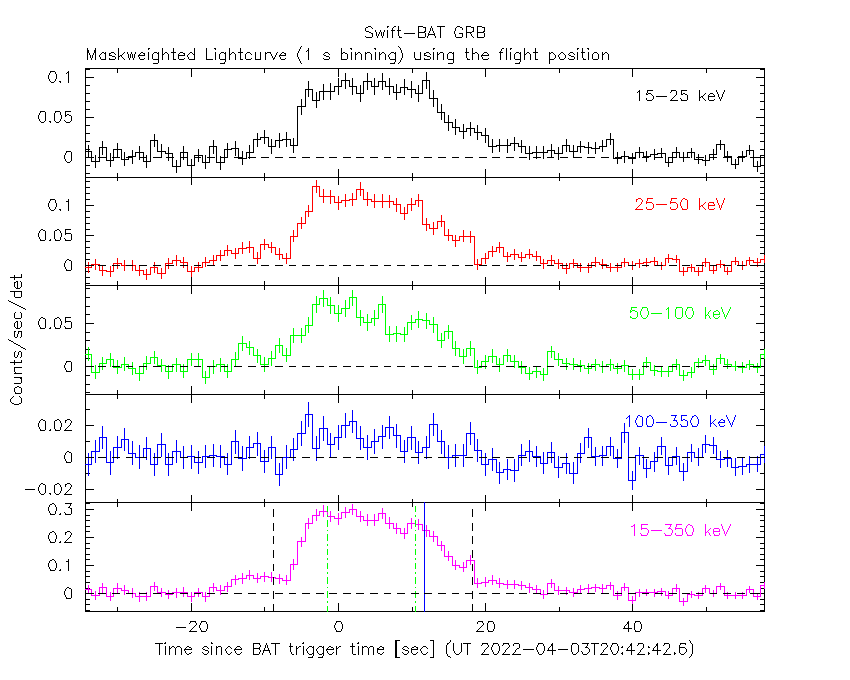
N.J. Klingler (GSFC/UMBC/CRESSTII) and A.P. Beardmore (U. Leicester) for the Swift team
At 20:42:42 UT, the Swift Burst Alert Telescope (BAT) triggered and located GRB 220403B (trigger=1101053) (Klingler et al. GCN Circ. 31820). Swift slewed immediately to the burst. At the time of the trigger, the initial BAT position was 85° from the Sun (11.8 hours East) and 75° from the 7%-illuminated Moon. Table 1 contains the best reported positions from Swift, and the latest XRT position can be viewed at http://www.swift.ac.uk/xrt_positions.
Klingler et al. (GCN Circ. 31820) reported the discovery with UVOT of an optical afterglow. Table 2 is a summary of GCN Circulars about this GRB from observatories other than Swift.
Standard analysis products for this burst are available at https://gcn.gsfc.nasa.gov/swift_gnd_ana.html.
As reported by Lien et al. (GCN Circ. 31834),
the BAT ground-calculated position is RA, Dec = 190.974, 89.180 deg which is RA(J2000) = 1
The mask-weighted light curve (Figure 1) shows a bright peak structure that starts at T-19 s, peaks at T-1 s and ends at T+40 s.
The time-averaged spectrum from T-14.42 to T+27.96 s is best fit by a simple power-law model.
The power law index of the time-averaged spectrum is 1.94 ± 0.06.
The fluence in the 15-150 keV band is 3.7 ± 0.1 x 1
The results of the batgrbproduct analysis are available at https://gcn.gsfc.nasa.gov/notices_s/1101053/BA/.
Analysis of the initial XRT data was reported by Beardmore et al. (GCN Circ. 31827). We have analysed 21 ks of XRT data for GRB 220403B, from 86 s to 264.0 ks after the BAT trigger. The data comprise 50 s in Windowed Timing (WT) mode (the first 9 s were taken while Swift was slewing) with the remainder in Photon Counting (PC) mode.
The light curve (Figure 2) can be modelled with a series of power-law decays. The initial decay index is α=4.4 ± 0.4. At T+236 s the decay flattens to an α of 0.26 ± 0.07 before breaking again at T+9375 s to a final decay with index α=1.16 (+0.16, -0.10).
A spectrum formed from the PC mode data can be fitted with an absorbed power-law with a photon spectral index of 1.90 (+0.16, -0.15). The best-fitting absorption column is 1.7 ± 0.5 x 1
A summary of the PC-mode spectrum is thus:
Total column: 1.7 ± 0.5 x 1
Galactic foreground: 1.2 x 1
Excess significance: <1.6 σ
Photon index: 1.90 (+0.16, -0.15)
The results of the XRT team automatic analysis are available at http://www.swift.ac.uk/xrt_products/01101053.
The Swift/UVOT began settled observations of the field of GRB 220403B 105 s after the BAT trigger
(Klingler GCN Circ. 31876).
A source consistent with the XRT position is detected in the initial UVOT exposures.
Table 3 gives preliminary
magnitudes using the UVOT photometric system
(Breeveld et al. 2011, AIP Conf. Proc., 1358, 373).
No correction has been made for the expected extinction in the Milky Way
corresponding to a reddening of

Figure 1. The BAT
mask-weighted light curve in the four individual and total
energy bands. The units are counts

Figure 2. The XRT light curve.
Any data from a crosshatched region are not included in the fit.
| RA (J2000) | Dec (J2000) | Error | Note | Reference |
|---|---|---|---|---|
| 1 |
+89°11'06.5" | 0.52" | UVOT-refined | Klingler GCN Circ. 31876 |
| 1 |
+89°11'04.7" | 3.5" | XRT-final | UKSSDC |
| 1 |
+89°11'04.6" | 3.5" | XRT-refined | Beardmore et al. GCN Circ. 31827 |
| 1 |
+89°10'49.0" | 1.0' | BAT-refined | Lien et al. GCN Circ. 31834 |
| Band | Authors | GCN Circ. | Subject | Observatory | Notes |
|---|---|---|---|---|---|
| Optical | Jelinek et al. | 31821 | optical detection by D50 | D50 | detection |
| Optical | Zhu et al. | 31823 | Nanshan/NEXT optical afterglow power-law decay |
Xinjiang Astro. Obs. | detection |
| Optical | Lipunov et al. | 31825 | Swift GRB 220403B: Global MASTER-Net observations report |
MASTER | |
| Optical | Rossi | 31826 | LBT observations | LBT | detection |
| Optical | 31830 | NUTTelA-TAO / BSTI Early Optical Limits (Preliminary) |
NUTTelA | upper limits | |
| Optical | Grossan et al. | 31830 | NUTTelA-TAO / BSTI Early Optical Limits (Preliminary) |
NUTTelA | upper limits |
| Optical | Pankov et al. | 31837 | Kitab optical observations | detection | |
| Optical | Hu et al. | 31841 | 1.5m OSN optical observation | Obs.de Sierra Nevada | |
| Optical | Pankov et al. | 31844 | Mondy optical upper limit | Mondy | upper limits |
| Optical | Ror et al. | 31869 | 1.3m DFOT Optical upper limit | DFOT | upper limits |
| Optical | Song et al. | 31883 | GRANDMA observations | GRANDMA | detection |
| Gamma-ray | Hamburg and Hristov | 31829 | Fermi GBM detection | Fermi GBM | Fluence=5.2±0.1x1 (brighter than 58% of long GRBs) |
| Filter | Exp(s) | Mag | ||
|---|---|---|---|---|
| white | 105 | 255 | 147 | 19.86 ± 0.12 |
| v | 647 | 1074 | 58 | >18.6 |
| b | 573 | 766 | 39 | >19.3 |
| u | 318 | 741 | 265 | 19.93 ± 0.22 |
| w1 | 697 | 716 | 19 | >18.9 |
| w2 | 797 | 1049 | 39 | >19.9 |
Table 3. UVOT observations reported by Klingler (GCN Circ. 31876). The start and stop times of the exposures are given in seconds since the BAT trigger. The preliminary detections and 3-σ upper limits are given. No correction has been made for extinction in the Milky Way.
April 13, 2022